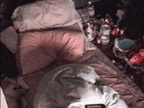:: Monday, June 21, 2004 ::
 NEW WRITING: on Eyal Weizman's "The Politics of Verticality" -- The role of the Israeli architecture in the Middle East conflict
NEW WRITING: on Eyal Weizman's "The Politics of Verticality" -- The role of the Israeli architecture in the Middle East conflict
BY: Ana L. Valdés
EXCERPT: Besides the religious and eschatological explanations, the architectural struggle is fought on several levels. As the American-Jewish anthropologist Jeff Halper writes in an essay, the water pipes and the sewage running through the West Bank and Gaza are also part of a meticulous "matrix of control." To control the water sources and the facilities' irrigation is a way to suffocate a country and to prevent it from developing. For thousands of years, Palestine has been an agricultural country where the olive trees have been the source for the families' wealth. Suddenly, Israel has become a country with thousands of greenhouses, producing tomatoes and cucumbers; oranges and avocados are exported while Palestine's water resources are drained. The opposition against this has been called the "Water Intifada." In Gaza, the population is obliged to buy bottled water, since the regular water contains too much sea water to be drinkable.
Eyal Weizman's essay, "Politics of Verticality," can be read at www.opendemocracy.net
An interview made by the visual artists Cecilia Parsberg and Erik Pauser can be found at http://this.is/TheWall
This article is available in both English and Spanish language versions.
click here for complete article in English.
click here for complete article in Spanish
 ORIGINALPOST: Saturday, June 12, 2004
ORIGINALPOST: Saturday, June 12, 2004BY: Daniele Balit
The presentation of the new site incident.net, a French collective of net artists, took place in Paris on June 3rd. Incident.net members' works were presented, as well as a selection of the Hors Seriés, an open project which proposes academic themes, like "still life," worked in with new-media practices.
From the many works of Gregory Chatonsky, one of the founders of Incident.net, I suggest checking out 1=1, a piece that splits the screen for a spatial editing of David Lynch's Lost Highway. The two parts of the movie are there for our (illusion of) control. A further deconstruction of that movie? You can try...
BetaGirl, by Reynald Drouhin, is a work on seeing and being seen. It's also the spectacle of the void, even if Airalin, the young girl who shows her intimate daily life on the Web, promises that the "rabbit hole into my world" (her web cam) conducts to Wonderland. Eating, sleeping, watching TV, Alice must have had a more exciting life! Drouhin’s editing transforms the insignificant images of a reality show into a narration, staged on a lonely bed. Many works of Drouhin are based on images composed through search engines, like in J'eux, where a child appears from a mosaic of several images resulting from the search-string "portrait."
Vadim Bernard, in Par[cours], develops his research, in progress, on visual interpolations between real and virtual space. With a bright mix of video and 3D, he rebuilds fragile models of some yards of Paris. The results presented in the QuickTime demo are encouraging for future developments.
KRN's photo self-portraits in the mirrors of all of the Ladies rooms' toilettes of NY is a work that doesn't need extra reflections, while Julie Morel in her CD-ROM, titled InAbsentia, presents a visual interaction through her handmade drawings and a marimbas piece by Steve Reich with the categories of daily objects. The on-line video of the project is not like the interaction with CD, but it gives us the idea.
 ORIGINALPOST: Sunday, June 13, 2004
ORIGINALPOST: Sunday, June 13, 2004BY: Kristen Palana
Any on- or off-line project that explores different cultures, languages, and people is sure to almost always win my heart. As an American who has been fortunate to travel, volunteer, and live abroad, I have often worked hard to counter the negative stereotypes people tend to have of us "Yanks," either due to our politicians, corporations, a bad movie they saw, or a loud tourist they encountered. I've often been jealous of people from other countries because I tend to get the impression from my country and others that it's the USA and EVERYONE ELSE. How wonderful it would be to fit in with EVERYONE ELSE and be a part of the world.
Bzzzpeek, by Agatha Jacquillat and Tomi Vollauschek, is an online project that is truly about THE WORLD. In this project, we are able to click on an animal or vehicle. We are then presented with up to seventeen representations of our choice, made different by the various flags representing their language or country. So, by clicking on a police car, for example, we hear that the English one makes a "woo woo," the German car goes "ta tu tah tah,ta tu tah tah," the South Korean car says "bee bo bee bo," and the Pakistani car goes "nee no nee no."
This project explores the similarity of children everywhere mimicking the world around them and celebrates the differences in which different cultures interpret the audible world. Because most of the sounds have been contributed by 2-7 year-olds who are native speakers of their respective languages, there is an atmosphere of innocence and multiculturalism--Globalization in a good way...
This project also takes submissions and offers to add languages not yet represented. Even though the American police cars are not represented (they go "weeeeeer weeeer," unlike Great Britain’s "woo woo"), I will happily just think of myself under the category of "English Speaker" and enjoy this growing and developing project that represents THE WORLD.